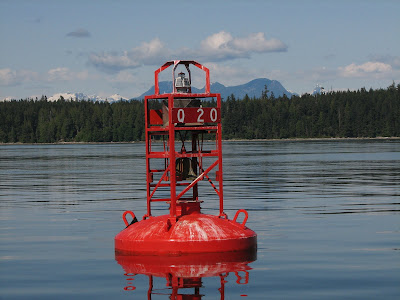Most of the advice I've read over the years suggest that, when float fishing on a still water, the float should be dotted right down, so only 1/4" or so is showing above the surface. The reason for this is usually stated as being either 1/ it makes everything more sensitive or 2/ it provides less resistance to a biting fish.
The physic in question here is bouyancy. Now, I'm no expert, so this is just a guess and if I'm wrong, my theory is shot. Here goes:
I think that the bouyancy of an object is the same whether the object is above the level of the water, level with it, or beneath it. So, a float with a tip say an inch above the water offers no more resistance to a biting fish than does a float which is submerged.
A float 1" above the water will move just a as much as a float 1/4" above it so there is no difference in sensitivity.
Having been through that rather dull and perhaps misguided attempt to explain physics let's look at a couple of practical fishing situations, and contrast the dotted down float against one with plenty showing:
Imagine the fish are playing around with the bait. The dotted down float disappears every time, suggesting a strong bite. A strike results, perhaps just as the float is rising to the surface. With a float with plenty showing, it's easier to read what's going on, and maybe time the strike better.
Consider a sail-away bite now. After the frustrations of all the knocks as described above a fish picks up the bait confidently. This might just be another finicky knock to the bloke with the dotted down float wheras the angler with an inch or so showing has a better idea of what is going on.
And then fishing fish a dotted down float puts more of a strain on your eyes, so is probably less enjoyable.
Any thoughts?
The physic in question here is bouyancy. Now, I'm no expert, so this is just a guess and if I'm wrong, my theory is shot. Here goes:
I think that the bouyancy of an object is the same whether the object is above the level of the water, level with it, or beneath it. So, a float with a tip say an inch above the water offers no more resistance to a biting fish than does a float which is submerged.
A float 1" above the water will move just a as much as a float 1/4" above it so there is no difference in sensitivity.
Having been through that rather dull and perhaps misguided attempt to explain physics let's look at a couple of practical fishing situations, and contrast the dotted down float against one with plenty showing:
Imagine the fish are playing around with the bait. The dotted down float disappears every time, suggesting a strong bite. A strike results, perhaps just as the float is rising to the surface. With a float with plenty showing, it's easier to read what's going on, and maybe time the strike better.
Consider a sail-away bite now. After the frustrations of all the knocks as described above a fish picks up the bait confidently. This might just be another finicky knock to the bloke with the dotted down float wheras the angler with an inch or so showing has a better idea of what is going on.
And then fishing fish a dotted down float puts more of a strain on your eyes, so is probably less enjoyable.
Any thoughts?


